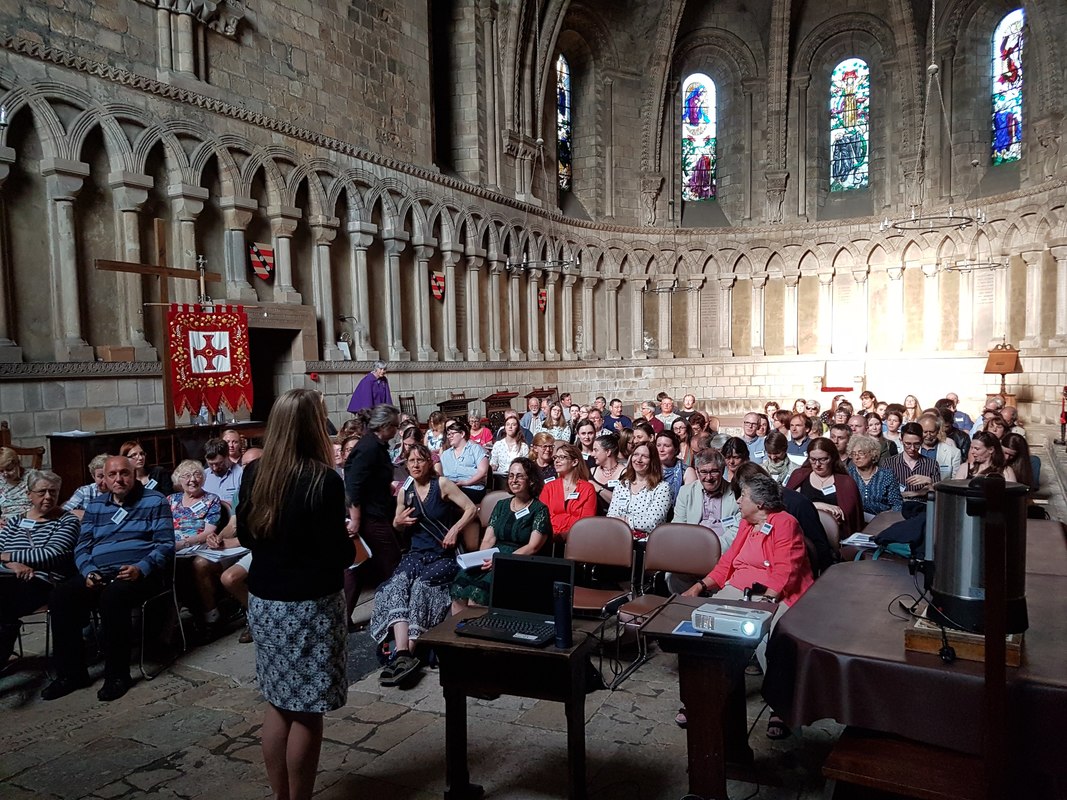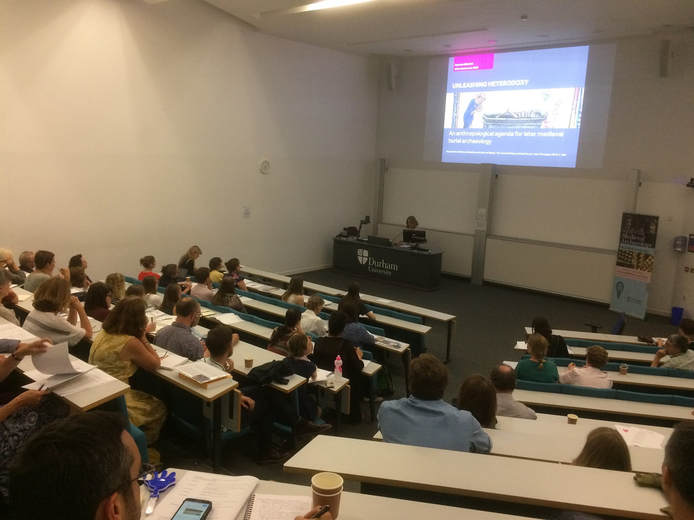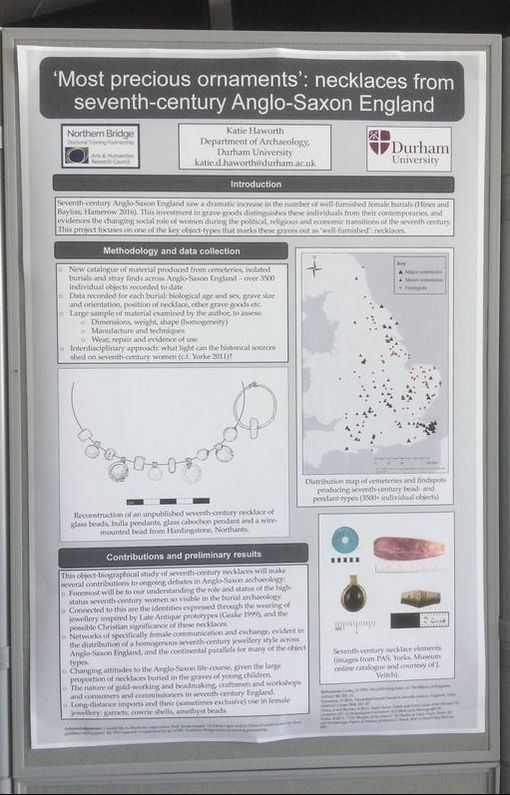This year’s Society for Medieval Archaeology annual conference took place at Durham University across the 13th to 15th of July, 2018. The conference, a collaboration between the Society and a Leverhulme-funded project hosted at Durham called People and Place: Creating the Kingdom of Northumbria, addressed the topic of death and burial in early to late medieval Britain and Europe.
Since 1990 a series of major conferences and publications have investigated aspects of death and burial in medieval societies in Europe and beyond. Some have delivered state-of-the-art research on early medieval and medieval funerary rites; others have profiled new advances in scientific research. The proceedings of the last SMA conference that dealt with burial were of course published in 2002 in the Society monograph series by Sam Lucy and Andrew Reynolds in the seminal volume Burial in Early Medieval England and Wales, which captured some of the major changes in thinking at the time on identity, community and belief. Since then spatial consideration has developed as a significant research strand in medieval archaeology, relevant to understanding settlement patterns, land use and travel and the experiential nature of monuments, places and landscapes. From exploring the distribution patterns of grave types and the use of antecedent landscape features for burial and charting the rise of commemorative markers in stone, to identifying patterns of diseases and health in medieval populations and their mobility; the location of the grave has become a rich stepping off point, stimulating and facilitating new research directions.
Since 1990 a series of major conferences and publications have investigated aspects of death and burial in medieval societies in Europe and beyond. Some have delivered state-of-the-art research on early medieval and medieval funerary rites; others have profiled new advances in scientific research. The proceedings of the last SMA conference that dealt with burial were of course published in 2002 in the Society monograph series by Sam Lucy and Andrew Reynolds in the seminal volume Burial in Early Medieval England and Wales, which captured some of the major changes in thinking at the time on identity, community and belief. Since then spatial consideration has developed as a significant research strand in medieval archaeology, relevant to understanding settlement patterns, land use and travel and the experiential nature of monuments, places and landscapes. From exploring the distribution patterns of grave types and the use of antecedent landscape features for burial and charting the rise of commemorative markers in stone, to identifying patterns of diseases and health in medieval populations and their mobility; the location of the grave has become a rich stepping off point, stimulating and facilitating new research directions.
The delegates convene for the opening keynote lecture by Professor Bonnie Effros (University of Liverpool) 'New eyes on ancient cemeteries? Merovingian mortuary archaeology in the age of Inrap'
With this in mind, the 2018 conference brought together established and early career researchers working on aspects of death, landscape and locality from AD 300-1500 in Britain and Europe. A key concern of the event was to promote new dialogues bridging early medieval, medieval and late medieval funerary archaeology and to initiate a broader transnational and comparative debate on methods, theories and approaches relevant to mortuary archaeology in the Middle Ages. The content delivered by our 21 speakers did not disappoint and it was particularly pleasing to listen to wide-ranging sessions that juxtaposed perspectives from Dalmatia and Pictland, or the Low Countries and Ireland, mixed scientific and social approaches and dissolved chronological divisions.
We were fortunate in having three exceptional and thought-provoking keynote papers. We started with a review of the treatment and exploration of Merovingian mortuary archaeology in past and present from Bonnie Effros on Friday evening in Durham Cathedral. Despite the imposing venue of the Cathedral Chapter House, our speaker kept the audience fully engaged in a critical reflection on the relevance of considering mortuary archaeology in context and a reception followed in the late evening light in the medieval cloister. On Saturday evening the audience heard an inspiring exploration of experiential and individual approaches to understanding human interactions with death in the medieval era from Roberta Gilchrist followed by another sunshine-filled reception at the poster evening in the Calman Centre with views over the historic Durham peninsular. Finally we closed on Sunday with a rich exploration of the architecture and grammar of mortuary archaeology in early Anglo-Saxon England from Duncan Sayer, leaving the audience with considerable food for thought on their journey home. In between our speakers provided new insights into cremation in Britain and the near Continent; explored the rich evidence for monument reuse in Scotland, Dalmatia and Francia; and charted the experiential nature of sculpture, burial and travel as elements of Norse tradition and in the context of Irish and western Christianity. Papers highlighted some recent seminal cemetery excavations such as Vicq in France and Lakenheath in Suffolk, while other speakers drew on the material evidence of the grave contents to explore aspects of ritual practice such as the use of gold coins, or the bioarchaeological contribution of skeletal assemblages. Important themes to emerge included the intersection of domestic and funerary spheres, the idea of resilient traditions during times of change, the importance of experiential approaches to graves, cemeteries and funerary landscapes and the need to individualise and anthropologise death and understand medieval experience.
We were fortunate in having three exceptional and thought-provoking keynote papers. We started with a review of the treatment and exploration of Merovingian mortuary archaeology in past and present from Bonnie Effros on Friday evening in Durham Cathedral. Despite the imposing venue of the Cathedral Chapter House, our speaker kept the audience fully engaged in a critical reflection on the relevance of considering mortuary archaeology in context and a reception followed in the late evening light in the medieval cloister. On Saturday evening the audience heard an inspiring exploration of experiential and individual approaches to understanding human interactions with death in the medieval era from Roberta Gilchrist followed by another sunshine-filled reception at the poster evening in the Calman Centre with views over the historic Durham peninsular. Finally we closed on Sunday with a rich exploration of the architecture and grammar of mortuary archaeology in early Anglo-Saxon England from Duncan Sayer, leaving the audience with considerable food for thought on their journey home. In between our speakers provided new insights into cremation in Britain and the near Continent; explored the rich evidence for monument reuse in Scotland, Dalmatia and Francia; and charted the experiential nature of sculpture, burial and travel as elements of Norse tradition and in the context of Irish and western Christianity. Papers highlighted some recent seminal cemetery excavations such as Vicq in France and Lakenheath in Suffolk, while other speakers drew on the material evidence of the grave contents to explore aspects of ritual practice such as the use of gold coins, or the bioarchaeological contribution of skeletal assemblages. Important themes to emerge included the intersection of domestic and funerary spheres, the idea of resilient traditions during times of change, the importance of experiential approaches to graves, cemeteries and funerary landscapes and the need to individualise and anthropologise death and understand medieval experience.
Professor Roberta Gilchrist (University of Reading) delivering one of the keynote lectures 'Unleashing Heterodoxy: An anthropological agenda for later medieval burial archaeology'
We were also fortunate in receiving a broad range of poster presentations. Some 20 posters were covered research topics including funerary practice in Normandy, the fifth-century Thames Valley, bioarchaeological perspectives on Anglo-Saxon bed burials, life and death in Ipswich, and micromorphological exploration of the Pictish grave fills at Rhynie, in Aberdeenshire, Scotland. The Society awarded prizes to two researchers for their posters on Riia M. Chmielowski for Viking-Age steatite: do household objects reveal real differences in status? And Celia Orsini for Monument reuse: localised identity, regional diversity and a poster by Elizabeth O’Brien and her team on the Mapping Death project in Ireland: People, Boundaries and Territories in Ireland, 1st to the 8th centuries AD was highly commended by the judges.
Poster by Katie Haworth (Durham University) "'Most precious ornaments': necklaces from seventh-century Anglo-Saxon England"
Thus in a friendly setting, the conference delivered state-of-the-art research and outlined new agendas in the field of medieval funerary rites. It also gave a voice to a range of new early career researchers alongside more established academics, providing attendees with a privileged insight into the up-and-coming new work that will no doubt change how we think about and use burial and cemetery evidence in medieval research in the decade to come.
Sarah Semple, Celia Orsini and Kate Mees, Durham University, UK
Sarah Semple, Celia Orsini and Kate Mees, Durham University, UK



 RSS Feed
RSS Feed
